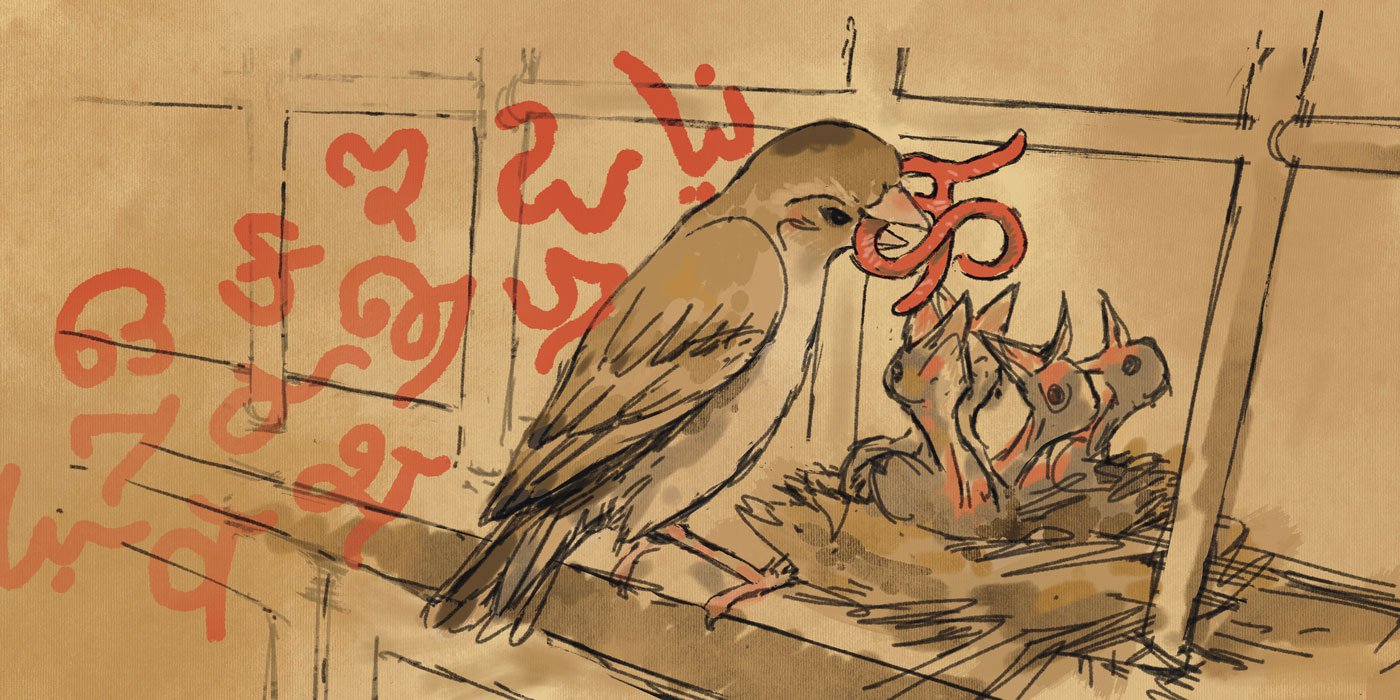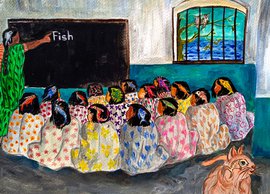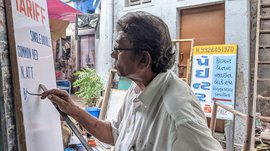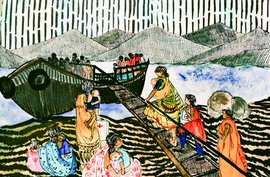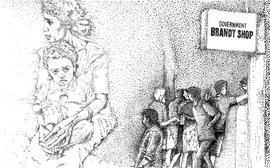It was one lazy winter afternoon in Delhi, with the January sun sitting in the verandas like a welcome guest when Qamar had called his mother, living about a thousand kilometres away. Speaking to the 75-year-old Shamima Khatoon, he was transported to his childhood home in Bari Phulwaria village of Bihar’s Sitamarhi district.
You would have certainly noticed something strange if you had heard the voices on both sides of the telephone line that afternoon. Speaking in clear Urdu, he asks, “ammi zhara ye bataiyega, bachpan mein jo mere sar pe zakham hota thaa na uska ilaj kaise karte the ? [Mother, tell me, how did you cure the rash that appeared on my head in childhood]?”
“Seer mein jo ho jaahayi – torohoo hola rahaa – batkhora kaha hayi oko idhar. Reh, chikni mitti lagaake dholiya rahaa, magar laga hayi bahut. Ta chhoot gelayi [The one that appears on the scalp – you also got that – is called batkhora here. I washed your head with reh [saline soil] and chikni mitti [clay], but it hurts badly. Finally, you got rid of it],” she laughs indulgently describing her home remedy, her language markedly different from Qamar’s.
There was nothing unusual about their exchange. Qamar and his mother have always spoken to each other in different languages.
“I
understand her dialect, but I can’t speak it. I say Urdu is my ‘mother tongue’ but my mother speaks in a different tongue,” he says the next day in the PARIBhasha meeting where we are discussing the topic for our story on the
International Mother Language Day. “No one has an idea about the name of her
language, neither Ammi nor anyone else in my family, not even those who speak
it,” he adds. Men who migrated from the village in search of work, like him, his father and his brother, never speak the language. Qamar’s children
are further estranged: they cannot understand their grandmother’s tongue.

A board at the entrance to the w restling school in rural western Maharashtra says taleem (Urdu for education). But the first thing you see within is an image of Hanuman, the deity of wrestlers (pehelwans) here. It's an image that speaks of a syncretic blend of cultures
“I have tried to find out more,” he adds. “A linguist from Aligarh Muslim University, Mohammad Jahangeer Warsi calls it ‘Maithili Urdu.’ Another professor, Rizwanur Rahman from Jawaharlal Nehru University (JNU) says that Muslims of this region of Bihar record Urdu officially as their mother tongue, but use a different dialect at home. It seems that mother’s language is a mixture of Urdu, Persian, Arabic, Hindi and Maithili – evolved in that region.”
A mother’s tongue that is getting lost with each successive generation.
That was it! Qamar had sent us on a word-hunt. We all decide to trace the footprints of some of the lost words in our own mother-tongues, follow the trail and pick up cues that could explain the loss. And before we knew we were staring into Borges Aleph .
*****
Raja is the first to speak. “There is a Tirukural couplet about a popular idiom in Tamil,” he says.
“
Mayir
Neeppin Vaazhaa Kavarima Annaar
Uyirneeppar
Maanam Varin [
Kural # 969
]
It translates like this: When hair is plucked from the body of a deer, it dies. Likewise, people who lose their respect, die of shame.
“The couplet compares a man's self-respect to the hair of a deer. At least, that's what the translation by Mu. Varatharasanar suggests,” Raja says hesitantly. “But why would a deer die if hair is plucked? Later on reading the Indologist, R. Balakrishnan’s article, Names of Tamil Villages in Indus Valley I understood that the couplet mentions ‘kavarima ’ that is a yak in Tamil and not ‘kavariman ,’ a deer.
“Yak?
But what is an animal found in the upper Himalayas doing in Tamil poetry, in a
language spoken by people at the other end of the country? R. Balakrishnan explains
it through civilisational migration. The Indus Valley people, according to him,
would have migrated to the south along with their native words, lifestyles,
locality names.”


A full grown Himalayan yak (left) and their pastoral Changpa owners (right). Kavarima, a word for yak, missing in modern Tamil dictionaries, is found in Sangam poetry
“Another scholar V. Arasu argued,” says Raja, “that one must not imagine the Indian subcontinent's history from today's idea of the nation-state or country. It is possible, he said that the whole landscape of the Indian subcontinent was once populated by people who spoke Dravidian languages. Having lived in an entire landscape from Indus Valley up the north to Sri Lanka down the south, it is no surprise that the Tamils have a word for an animal that lives in the Himalayas.”
“ Kavarima – a word of wonder!” exclaims Raja. “Interestingly, the renowned Tamil dictionary Crea does not have the word kavarima in it.”
*****
Many more among us had stories of words not found in dictionaries anymore. Joshua names it – the politics of standardisation.
“Through centuries, Bengal's farmers, potters, homemakers, poets and craftspeople communicated and wrote in their own regional tongues – Rarhi, Varendri, Manbhumi, Rangpuri, etc. But, with the coming of the Bengal Renaissance in the 19th and early 20th centuries, Bangla lost much of its regional and Arabo-Persian lexicon. Successive waves of standardisation and modernisation went hand-in-hand with Sanskritisation and an influx of Anglophonic, Europeanised words and idioms. It robbed Bangla of its pluralistic nature. Since then, words deeply rooted in or borrowed from Adivasi languages like Santali, Kurmali, Rajbongshi, Kurukh and others are being erased.”
The story is not exclusive to Bengal. Every language in India has an equivalent for an old saying, baar gau e boli badalay (There’s a different tongue to be heard every 12-15 kilometres). And every state in India, during colonialism, during the linguistic division of states post Independence and after, has undergone a similar process of erosion. The story of the state language in India has been historically fraught with cultural and political implications.
“I come from Bankura,” says Joshua, “the heartland of the erstwhile Mallabhum kingdom. It's a region shared by multiple ethnolinguistic groups, resulting in a near-continuous exchange in language, customs and more. Every language in the region has myriad loan words and inflections from Kurmali, Santali, Bhumij and Birhori.

The story of the state language in India is historically fraught with cultural and political implications
“But, in the name of standardisation and modernisation words like arha [land], jumrhakucha [burnt wood], kakti [tortoise], jorh [stream], agrha [hollow], bilati begun [tomato] and many more are being steadily replaced by highly Sanskritised and Europeanised phrases developed by people belonging to the upper-class, upper-caste bloc of colonial Calcutta,” Joshua adds.
*****
But what gets lost when a word disappears? Is it the word that vanishes first or the meanings? Or is it the context, creating a void in the language? But doesn’t something new come up in the hollow spaces left behind by the loss?
When a new word,
‘uralpool’
[flying bridge], becomes the new
Bengali equivalent for a flyover – do we lose something, or do we gain? And does
that which was lost in the process account for much more than the sum of what
we have now added? Smita is thinking aloud.
She recalls an old word in Bangla, ghulghuli – traditional ventilators placed below the roof for some air and light. “We don’t have those anymore,” she says. “About 10 centuries ago, a wise woman, Khana, writes Khanar Bachan , a collection of her proverbial Bengali couplets. There she writes about agriculture, health and medicine, meteorology, home construction with astonishing pragmatism.
Alo hawa bendho na
Roge bhoge moro na.
Don’t build a room sans air and light.
Die of sickness, you just might.
Pirhe unchu mejhe khal
Tar dukkho sorbokal.
Floor is lower than the land outside
Its gloom and doom can never hide.
Our ancestors trusted Khana’s wisdom and made space
for
ghulghuli
in our homes,” Smita adds. “But in the modern-day homogenised
housings projects that commoners get under various housing schemes initiated
through the state’s social security, there is no space for traditional wisdom.
Walls with embedded shelves, and alcoves known as
kulungi
, open spaces
called
chatal,
are obsolete ideas. The
ghulghuli
has disappeared,
so has the word from popular parlance,” she says.

Changing architectural designs mean that words in Bangla like ghulghuli ( traditional ventilator), kulungi ( shelves) and alcoves embeded in walls, and chatal ( open spaces), are no longer part of our daily lexicon
But it is not just the word, or the ghulghuli itself that she is lamenting in these times when houses themselves have turned into pigeonholes. Smita is also mourning the rupture of this delicate connection we once had with other creatures, with nature, with the numbers of house sparrows that once made their little nests in those ventilators.
*****
“The havoc of the mobile towers, the pucca houses isolated from the outside, our closed kitchens, the excessive use of herbicides and pesticides in our farms," says Kamaljit, "are all to be blamed for the declining presence of the house sparrows from our homes, gardens, and songs.”
There! She had explained an important connection between linguistic and ecological diversity. Quoting a couple of lines from the Punjabi poet Warish Shah she adds:
“Chiri
chookdi nal ja ture pandhi,
Paiyan dudh de vich madhaniyan ni.
Travelers
set out as soon as sparrows speak,
Just as a woman churns butter from the milk.
There was a time when farmers started their day, and wayfarers began their journey with the chirping of house-sparrows. Those were our natural, miniature alarm-systems. Nowadays I wake up to a recorded sound of their chirping on my phone. Farmers predicted the seasons, planned their crop-cycles based on these avians' behaviour. Certain movement of their wings were auspicious – kisani ka shugun .
Chiriyan
khambh khilere,
Vassan meehn bahutere.
Whenever
a sparrow spreads her wings
A downpour shall the heavens bring.

House sparrows were once routinely spotted in our homes, fields and songs. Movement of their wings were auspicious – kisani ka shugun
It is no coincidence that we find ourselves in the middle of massive biological annihilation. With the disappearing of species of plants, animals and birds, we also face a significant decline in our linguistic and cultural diversity. Dr. Ganesh Devy in People’s Linguistic Survey of India in 2010, notes the alarming rate at which languages are dying in India – about 250 over the last 60 years.
When the ornithologists have been vocal about the declining number of sparrows in Punjab , Kamaljit remembers an old folk song sung at wedding times.
Sada
chiriyan da chamba ve,
Babul asan udd jana.
Just
like the sparrows we are, we are,
We must leave our nest, and fly afar.
"Sparrows were regularly spotted in our folk songs. But alas, not anymore,” she says.
*****
Even disappearing livelihoods are linked to language, observes Pankaj, just like the climate crisis and migration. “Nowadays markets in Rangia, Goreswar and everywhere else in Assam are overflowing with cheap machine-made gamochas [thin, coarse cotton cloth traditionally used as a towel, a scarf, or a turban] and chador-mekhela [a traditional wrap and a waistcloth for women] supplied from other states. The traditional handloom industry in Assam is dying, and with it our native products and words related to weaving,” he says.
“Akshay Das is 72 years old and his family practises handloom weaving in Bhehbari village of Assam, even today. He said that the skill is lost. 'Young people migrate to Guwahati, some 60 kilometres from the village for work. Away from the weaving tradition, they won’t know words like sereki'. ” Akshay is referring to a bamboo girdle used for winding thread in smaller loops around a mohura (a spool) with the help of a spinning wheel called jotor .

Distanced from the traditional weaving practice, the young generation in Assam don't know words like sereki , or what it means to 'dance like a sereki' when we sing a Bihu song
“I remember a Bihu song,” Pankaj says, “ sereki ghuradi naas [dance like a spinning sereki] . What can any young person who does not have the context make of it? Akshay’s 67-year-old sister-in-law, Bilati Das, [wife of his late elder brother, Narayan Das], was singing another song:
Tetelir tolote, kapur boi asilo, soraiye sigile xuta.
I was weaving beneath the tamarind tree, birds have torn the threads.
She explained the process of weaving warps to me and said that as the new tools and machines flood the market many local tools and techniques are getting lost.
*****
“We are into sarvanash technology,” says Nirmal with a mysterious laugh.
“Recently, I went on an expedition of sorts in my village Patandadar in Chhattisgarh.” Nirmal begins to tell his story: “I was looking for doob [Bermuda grass] for a puja we were having. I first went to the kitchen garden in the backyard but couldn’t find a single blade of doob [ Cynodon dactylon ]. So, I went to the fields.
“It was a few months before harvest, a time when the new-born paddy-ears fill up with milky sweet sap and farmers flock to their farms to worship. They also use the same sacred grass. I walked across the fields but the soil that should have been like velvet to my feet, dewdrops sparkling across tufts of grass, was dry. Bermuda grass, normal grass, kaandi [green fodder], everything had vanished. Every single blade had withered, burnt to a crisp!”
“When
I asked someone working on the field, he said, '
sarvanash' dala gaya
hai, isliye
[because doom has been sprayed]'.” It took me a while to
figure out that he was referring to some herbicide by a certain brand name. He
did not say
ninda nashak
[weed killer] as one would in Chhattisgarhi, or
ghaas mara
in Odia that we often speak, or
kharpatwar nashak
and
charamar
like in some Hindi-speaking regions. The word '
sarvanash'
had come
to replace them all!”


Increasing use of pesticides, chemical fertilisers and technologies have come to dominate agriculture, destroying India's rich diversity that farmers like Syed Ghani Khan, in Karnataka's Kirigavalu is trying to preserve. His house walls (right) are lined with paddy flowers with details about each variety. A loss of agricultural diversity can be seen to be linked to the loss in linguistic diversity
The anthropocentric logic of exploiting every inch of land and turning it into a productive field for our own survival has led chemical fertilisers, pesticides and technologies to dominate agriculture. Even a farmer, who barely owns an acre, says Nirmal, is more likely to hire a tractor than use traditional tools.
“Day and night the tube wells are pumping up water and leaving our mother earth barren. Maati mahtari , her womb [topsoil] is forced to conceive every six months,” he says in a distressed voice. “How long can she bear toxic chemicals like 'sarvanash'? Poison-filled crops will soon find their way into human blood. I can feel our own impending apocalypse.
“As for the language,” Nirmal continues, “a middle-aged farmer once told me, naagar [plough], bakhar [a weeding tool], kopar [wooden club used for breaking clay lumps] – no one even knows the names. And daunri belan [a bullock driven roller-thresher] belongs to another space altogether.”
“Just like metikamba ,” says Shankar.
“I remember we used to have this pole, metikamba , in our courtyard in Vandse village, in Udupi, Karnataka,” he reminiscences. “It literally meant the pole of agriculture. We used to tie a bench – hadimancha to it . We used to thrash paddy grass against it to separate rice from it. We also used to tie a bull to it and make it go around on paddy grass to remove the remaining grains. Now the pole has vanished; with modern harvesting machines the process is easy,” Shankar says.
“To
have a
metikamba
in front of one’s house was a matter of pride. Once a
year we used to perform a puja for it and feast on some really good food! The
pole, the puja, the feast, the word, a whole world – now gone.”
*****
“There is a song in Bhojpuri,” Swarn Kanta says, “Hardi hardpur jaiha e baba, sone ke kudaali hardi korih e baba [Father, please bring me turmeric from Hardpur, dig the turmeric up with a golden spade]. It used to be sung during the ubtan [turmeric paste application] ceremony in weddings across Bhojpuri-speaking regions. Earlier, people used to go to their relatives' homes and grind turmeric using a jaanta [grind mill]. Now there are no grind mills in their houses, and the ritual has gone.
![In Bhojpuri they sing a song during ubtan (haldi) ceremony in a wedding, 'hardi hardpur jaiha e baba, sone ke kudaali hardi korih e baba, [ father, please bring me turmeric from Hardpur, dig the turmeric up with a golden spade ]](/media/images/09-_AMI5958-PBT-Words-worlds_in_a_grain_of.max-1400x1120.jpg)
In Bhojpuri they sing a song during
ubtan (haldi)
ceremony in a wedding,
'hardi hardpur jaiha e baba, sone ke kudaali hardi korih e baba, [
father, please bring me turmeric from Hardpur, dig the turmeric up with a golden spade
]


There are no
silaut (
flat grinding stone), no
lodha (
type of pestle), no
khal-moosal (
mortar and pestle) in modern, urban kitchens nor in our songs
" The other day my distant cousin's wife and I noticed how a number of the Bhojpuri words associated with an ubtan song – kodal [spade], korna [digging], ubtan [bathing with turmeric] , sinhora [kumkum-box] , doob [Bermuda grass] – are no longer heard," says Swarn Kanta, speaking about the way cultural loss is being felt in urban India.
*****
We are all speaking from our own different and subjective spatial, cultural, class locations. And yet we are all concerned about the same loss of words and their shrinking connotations, the way they had gone hand-in-hand with our weakening relationship with our own roots, with the environment, with nature, with our villages, our forests. Somewhere along we had started playing a very different game called 'progress'.
Talking of games, they too have been lost with time. Sudhamayi and Devesh are wrapped in a conversation about precisely that. “If you asked me about the games that the children no longer play,” Sudhamayi says, “I will give you a list – gacchakaayalu or vallanchi - where you toss the pebbles in the air and catch them on the back of your palm; omanaguntalu , played with cowries or tamarind seeds and 14 holes or pits in two rows set on a table, kallagantalu , a game of catch where the chaser is blindfolded, and many more,” she says.
“I have memories associated with games like 'sateelo' ,” says Devesh. There are two teams and seven stones placed one on top of the other. One team aims and throws a ball to topple the stone tower, and the other team must rebuild the tower without getting out. At some point when we boys got bored, we invented a game called 'gena bhadbhad'. There was no end goal, no teams. Everyone just targeted each other with the ball! One could get hurt playing it, so it was referred to as a 'boys' game'. Girls did not play gena bhadbhad .”
“I never played any of the games I mentioned,” says Sudhamayi, “I only remember hearing about them from my maternal grandmother, Gajulavarti Satya Vedam. She was from Chinagadelavarru, a place about 17 kilometres from my village in Kolakaluru. I do not know much about her but have a distinct memory of listening to her stories about these games that she spoke about while feeding me or putting me to sleep. I couldn’t play, I had to go to school!”
“The girls in our locality played 'gutte' with stone-chips,” says Devesh “or 'bish-amrit' [poison-nectar] — the aim was to either catch or save the other team. I also remember a game called 'langdi taang' , in which the players hopped on one leg within the nine squares drawn on the ground. A version of hopscotch.
“Children didn’t grow up with a digital device in their hands, robbing them of both their childhood, and their language. Today my 5-year-old nephew Harshit in Bakhira, my niece Bhairavi, 6, in Gorakhpur don’t even know the names of these games,” says Devesh.

Devesh has a vivid memory of playing sateelo as a child, but his young niece and nephew today do not even know the name of the game

Young boys in Kivaibalega village of Chattisgarh playing horse riding. The game is known as ghodondi in the Halbi and Gondi languages
*****
But isn't some amount of loss inevitable? Pranati keeps debating in her mind. Don’t the changes in certain fields automatically change our language? Rapid advances in scientific knowledge, for example, about numerous diseases, their causes and prevention, the spread of that awareness among people alters the way they look at them. Or at least the way they identify them. How else does one explain a certain scientific vocabulary entering local languages in Orissa?
“In the villages once,” she says, “we had different names for diseases; smallpox was badi maa ; chickenpox was choti maa ; diarrhoea was either badi, haija , or amashay ; typhoid was antrika jwar . We even had words for diabetes – bahumutra , arthritis – ganthibaat , and leprosy – bada roga . But today people are slowly pushing these Odia words aside, making space for the English ones in their vocabulary. Should this be a cause of lament? I’m not sure.”
We know, whether we are linguists or not, that language is not static. It is a river, forever flowing
across space, social groups, time; always changing, disseminating,
assimilating, contracting, fading, innovating. Then why make such a hullabaloo about
loss and memory? Isn’t some amount of forgetting good?
*****
“I am thinking of the many social structures that lurk behind our languages. Look at a word like murdaad mutton ,” says Medha. “We often use this for someone ‘stubborn’, not moved by any word or situation, like murdaad mutton , dead meat that Dalits in many villages were compelled to eat. That where the term comes from.”
Rajeeve
began to think about Malayalam. “Once the dwelling of lower caste people in
Kerala,” he says, “were called
chetta,
a thatched house. It also came to
be a term of abuse as it referred to the lower caste people living in such
houses. They were not allowed to call their dwellings
pura
or
veedu,
which were reserved for the homes of higher castes. Their newborns were not
unni
like that of upper caste people, but
chekkans
meaning brats. They even
had to address themselves as
adiyan,
‘your obedient servant’, in the
presence of upper-caste people. These words are not used anymore,” he says.


Unjust social structures are also embeded in our languages. We need to
consciously pull out and discard the words that prepetrate injustice from our
vocabulary
“It is good for some words and usages to be lost forever,” says Medha. “Dalit leader from Marathwada, Adv Eknath Awad speaks about a language that was created by him and his friends in his autobiography [ Strike a blow to change the world as translated by Jerry Pinto]. They belonged to Matang and other Dalit castes, and lived in dire poverty, stealing food. Their secret language was to help them survive, alert each other and flee before getting caught. 'Jija', as he was fondly known, says that ‘this language should be forgotten. No one should know it and need to use it ever again’."
“Dipali Bhusnar and Adv. Nitin Waghmare from Sangola in Solapur district list many words and proverbs, like Kaay Mang Garudyasarakha rahatuy? [Why do you look like a Mang or a Garudi?] The usage suggests a lack of personal care and cleanliness among Dalits, living amidst extreme poverty and caste discrimination. But in a language entrenched in caste hierarchies equating a person with a Pardhi, Mang, Mahar was the ultimate insult. We must weed such words out.”
*****
There has to be something that needs to be salvaged. The crisis of our languages is not an imaginary one. If it is like 'the first canary in the coalmine' as Peggy Mohan would say. Is there worse to come? Are we heading towards a mass extinction of our diversity as people, as a culture? Do we find its beginning here in languages? And where does it end, the redemption?
“Well, where else but in our own languages,” says 69-year-old Jayant Parmar. He is a Dalit Gujarati poet writing in Urdu.
“There were a lot of Urdu words that
ma
used in her Gujarati,” he says speaking of
his, and his mother Dahiben Parmar's relationship with the language. “Asking me to bring a particular vessel she
would say,
“Ja, 'kado' lai aav khava kadhu
. I am not sure if those
types of vessels exist anymore, in which we used to mix and eat rice. After
reading Ghalib I realised the word is
kada
,” he adds.

There was a time when people from all communities lived together inside the walled cities; the climate was not communal, and there was a lot of give and take that reflected in cultures, architecture, literature and language
“There were many sentences like that “ Tara 'deedar' to jo ,” (Just pay attention to your appearance), “ Taru 'khamis' dhova aap [Let me put your your shirt for a wash], “ Monhmathi ek 'haraf' kadhto nathi [Can you not speak even a word from your mouth?]” Or she would say, “ Mullane tyanthi 'gosh' lai aav [Go get some meat from Mullah’s house]. The word is gosht – but in spoken language we called it gosh . These words that were part of our boli are now being forgotten. Anytime when I see these words in Urdu poems, I see my mother’s image there.”
Things are different now, the climate, the geography of the city. “Then people from all communities lived together inside Ahmedabad’s walled city; the culture was not communal. During Diwali our Muslim friends received sweets and savoury mixtures from our house. We would hug each other. We all used to go and watch the Tazia procession during Muharram. Some of them were beautiful, finely decorated domes for fairies. Little ones would pass under those and ask for their happiness and health,” he says.
There was aadan-pradaan , a genuine, free exchange. “We are no longer living in the same climate and that shows in our languages,” he says. “But the hope is in poetry. I know Marathi, Punjabi, Bengali, and bring in many words from these into Urdu. Because I believe it is only in poetry that these can be saved.”
What are words, but worlds in a grain of sand.
This multilocation piece was made possible with contributions from several PARIBhasha members – Devesh (Hindi), Joshua Bodhinetra (Bangla), Kamaljit Kaur (Punjabi), Medha Kale (Marathi), Mohd Qamar Tabrez (Urdu), Nirmal Kumar Sahu (Chhattisgarhi), Pankaj Das (Assamese), Pranati Parida (Odia) , Rajasangeethan (Tamil), Rajeeve Chelanat (Malayalam), Smita Khator (Bangla), Swarn Kanta (Bhojpuri), Shankar N. Kenchanuru (Kannada), and Sudhamayi Sattenapalli (Telugu).
We thank Jayant Parmar (Gujarati Dalit poet writing in Urdu), Aakanksha, Antara Raman, Manjula Masthikatte, P. Sainath, Purusottam Thakur, Ritayan Mukherjee, and Sanket Jain for their contributions.
This story is edited by Pratishtha Pandya with support from P. Sainath, Priti David, Smita Khator, Medha Kale. Translations support: Joshua Bodhinetra. Photo editing and layout: Binaifer Bharucha.
